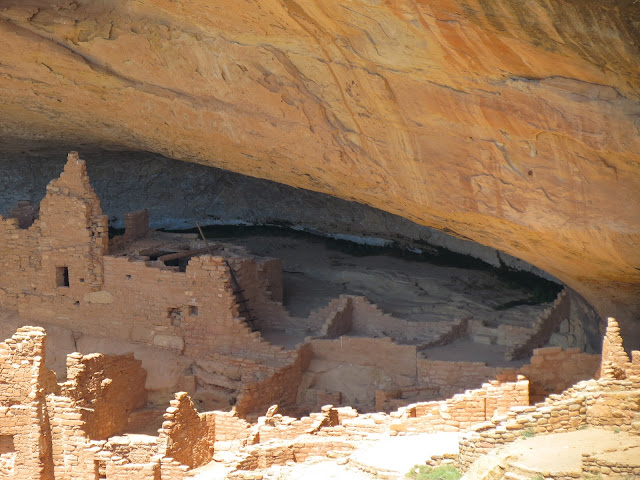Kodak House
Diagram Of What Kodak House May Have Looked Like
Kodak House As It Is Today
Cliff House Remains
Cliff Dwelling Ruins. Note Dwellings On Two Levels Of Cliff
Closer View Of Some Of The Ruins
Cliff Dwellings
Closer View Of Ruins. You Can Clearly See The Various Rooms
Another Close Up Of The Above Dwellings. Notice A Tour Group
Is In The Site Climbing A Ladder To Reach A Higher Level
The Above Cliff Dwelling Site From A Overlook Point
From Across The Canyon
Wetherill Mesa which forms part of the western border of Mesa Verde National Park contains the second largest concentration of ruins in the area. In 1958 a survey of the area documented nearly 900 sites ranging in age from the Modified Basket maker pit houses ( A. D. 450 to 750 ) to the Classic Pueblo cliff dwellings ( A. D. 1200 to 1300 ). During this time, this was an excellent location and could have accommodated probably 1,000 to 2,000 ancient people. There must have been many settlements on Wetherill Mesa because of the thousands of acres of flat Mesa top land for the growing of crops. As noted earlier there was rain and snow on the Mesa but the amount varied from year to year causing drought years. During these drought years the ancients developed a system of water storage reservoirs and check dams which insured at least a minimal harvest to sustain life. Almost 1,000 of these check dams have been discovered. Near Steep House in one quarter mile over 100 terraces have been found. The ecosystem on the Mesa was no different than we find today in most parts of the world. The constant occupation, cultivation, cutting of timber for fuel, building and clearing for more farming, and expanding population took its toll. Increased hunting of animals for food, hides, and bones probably reduced the supply of these animals. Then in the late 1200's there was a severe drougth and this created a situation in which the ancient people could no longer survive so they left and moved elsewhere. By the 1300's only the empty cliff dwellings and broken fragments of pottery were left of the ancient culture that remained.
Wetherill Brothers Discover Long House
Long House
Long House. Notice The Round Kiva In Front.
The Long House is the largest cliff dwelling in Mesa Verde and contains 150 rooms, 21 Kivas and an unusually large central plaza. It got its name because of its long overhang. It could have accommodated 150 to 175 people. Using only simple tools, the building of such as large dwelling place must have taken a lot of time, materials and people. In some instances the structures were 3 stories high. Also to be considered was the need for water. They were fortunate in this instance because there was a seep spring in the back of the cave. On the ledges above the main parts of the pueblo are remnants of storage rooms which were reached by ladders from the roofs of lower buildings. The practice of these dwellers was to dispose of their trash in front of their dwellings. Can you imagine what a lovely smell this would have been. So there was an area in front of Long House that served as the trash dump. During excavation various items were found: such as, food remains, broken pottery pieces, discarded scandals, bone and stone tools no longer needed,and a wide variety of other utensils. Also, 28 burials were found in the trash dump along with their associated artifacts, blankets, pottery, and jewelry. As noted earlier a unique feature of Long House is the large central plaza. Speculation is that it was a great Kiva or a dance plaza and was probably used for ceremonial or secular activities of the village. There were benches along the edge for people to sit and observe whatever was taking place. On either side of the large fire pit are recessed areas which may have served as " foot drums ". As noted this is speculation but if true just imagine the sound coming from these foot drums and echoing down the canyon as these people perhaps performed their dances. ( Think about your noisy neighbors having a party. ) There is only one other location that has something similar to this plaza and that is in Fire Temple in Fewkes Canyon on Chapin Mesa.
Spruce Tree House
Spruce Tree House. They Moved Off The Mesa To Build
Dwellings Such As Spruce Tree House along The Cliffs
Spruce Tree House
Spruce Tree House
Another View Of Spruce Tree house
Another View Of Spruce Tree House
You know folks the same thing happens out here on the west coast as it does on the east coast it gets late to quick and the old body says it is time to stop having so much fun and go to bed so that is exactly what I am going to do. So as usual don't forget God loves you and so do I.
In the next posting I will continue to explore more history of the Pubelo People ( The Ancient People ).
Good night.
Grandpa Bill




















No comments:
Post a Comment